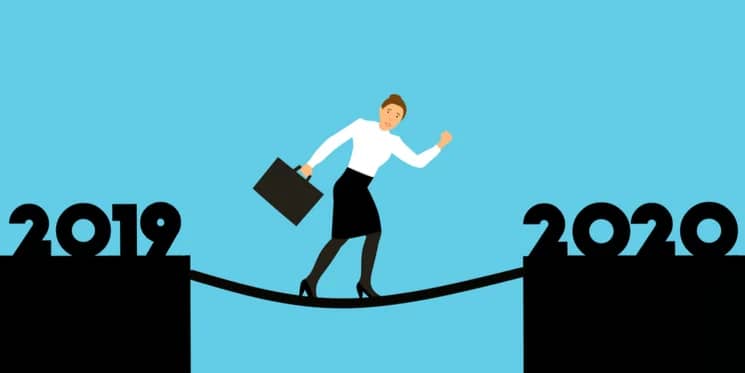Wow, can you believe 2020 is just 3 months away?
It was just a short decade ago that we were getting to grips with Facebook and preparing ourselves for the onset of social media.
Rewind another ten years, and we were anticipating the 'millennium bug'.
Today, we communicate with bots on a daily basis, we ask our smart home hub whether we need an umbrella or sun cream, and our toddlers can unlock and scroll before they can say "Wifi".
When you stop and reflect on how far we've come in such a short space of time, it's pretty fascinating.
This is the future. And as B2B marketers we need to pay attention to how quickly trends are shifting and how consequently, consumer behaviour is changing. We need to be agile and adapt our strategies if we want to stay ahead and stay relevant.
I’ve been doing a little research of my own. And while it’s early days (currently September 2019), here’s what I’ve noticed are set to be the biggest trends of 2020.
Chatbots will really own customer service
As I stated above, we deal with bots pretty much every day. Whether we consciously notice this or not.
Chatbots are just one form, but the technology is being harnessed by more and more B2B businesses as a way of bridging the gap between that first touch and a conversion.
It’s not uncommon for chatbots to greet you on the homepage of a B2B company website, brimming with joy, funny quips (or irreversible blunders!) and a library of information in their archives. They're ready to respond to your most common enquiries, and it's often chatbots that will respond almost immediately to Tweets and Facebook messages.
But now they're becoming more sophisticated and beginning to grasp a better understanding of context, helping them deliver more relevant and accurate solutions to customer queries.
Chatbots can answer questions in real time either verbally or by directing the user towards the correct resources. In the case of B2B, that might include relevant marketing literature or landing pages.
They don't require holidays or time off like we do, so they can be responsive 24/7. Their mood is consistent and predictable, they are reliable, and they can take much of the workload off your teams, giving us humans more time focusing on nurturing MQLs and existing customers. As we grow to depend on bots to manage a large proportion of customer enquiries, we'll be able to invest more time and mental energy into improving the overall customer experience.
Increased spend on video
We already know the prominence of video in the social and marketing spaces. But the scope of what is to come is unprecedented.
There are multiple benefits to using video for the purpose of content marketing. It's visual, highly inclusive, versatile, and accessible.
81% of online users skim content and only remember about 20% of what they read. How do we overcome this? Supplement or replace written content with video.
While blogging is certainly not dead, video will continue to grow as one of the most effective avenues for delivering key messages, 'how-to' content and highlighting key product features.
Webinars will almost certainly increase too, as a way of engaging with future prospects and demonstrating knowledge and subject matter expertise, helping you to establish authority in your industry.
Increased use of AI (artificial intelligence)
AI in marketing uses machine learning techniques to improve the customer experience. And that's just one of its many functions.
It's predicted that AI will be used more for bringing together disparate sources of data and performing automated analysis.
This application will precede a new mindset that focuses on growth, analysis, engagement and experiential metrics.
AI application at its most sophisticated can aid in content generation and creations, as well as experience composition, helping to deliver digital experiences involving augmented reality and virtual reality.
AI will be able to significantly enhance the entire buyer's journey through the addition of digital experiences for customers and prospects.
It's an exciting time or the evolution of AI. Integrating its functions with marketing opens up more and more doors for the modern marketer.
Less superfluous content
Content overload means marketers will be investing their time to create more meaningful content that has the power to stand out. This could see an increase in experimentation with formats, subjects and types of content.
As opposed to simply producing content for the sake of producing content, marketers will take on the attitude of less is more - spending more time on high quality, relevant content and culling the superfluous.
Martech and predictive advertising
With increased technological applications in the marketing industry we'll see the rise of 'martech' - the blending of marketing and technology - in aiding marketers to leverage AI, data and predictive advertising to improve the customer experience.
The landscape is incredibly new and complex and the majority of marketers are still learning how to best navigate it. Applications we can expect to see more of include the accessibility of customer date in real time, increased personalisation of campaigns and targeting, and the use of data to create predictive analysis of customer behaviour.
We could also see more mundane, repetitive tasks becoming automated, freeing up valuable time for team members.
2020 is set to be a progressive year for the marketing industry as we learn to harness and work with developing technologies. As we navigate our way around this new landscape, I believe we'll discover new ways to understand our customers better and communicate with them more effectively. These are just a handful of emerging trends but it will always pay to keep one eye firmly on new movements within the industry. Let's see how these trends play out and if we can use any of them to our advantage in the inbound/content marketing world.


